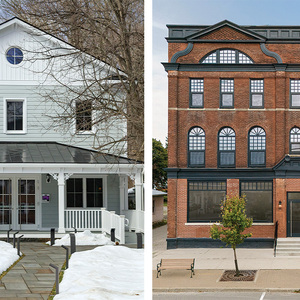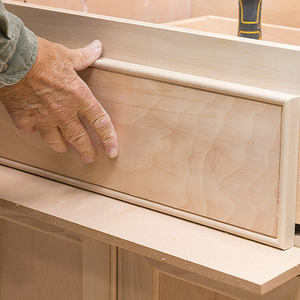*
The stone foundation for my 100+ year old home has shifted a few degrees outwards, moving the sill plate with it. A contractor suggested installing a 3/4″ steel threaded rod thru the sill from the outside, running it thru the joists and again thru the other sill to the outside. There would be nuts on the outer part of the sill, and a turnbuckle inside to snug things up…the intent being so prevent outwards shifting of the sill Has anyone had experience with this?
Discussion Forum
Discussion Forum
Up Next
Video Shorts
Featured Story

Listeners write in about air-sealing numbers and wildfire recovery, before asking questions about replacing a row house roof and what kind of roof insulation is needed.
Highlights
"I have learned so much thanks to the searchable articles on the FHB website. I can confidently say that I expect to be a life-long subscriber." - M.K.
Fine Homebuilding Magazine
- Home Group
- Antique Trader
- Arts & Crafts Homes
- Bank Note Reporter
- Cabin Life
- Cuisine at Home
- Fine Gardening
- Fine Woodworking
- Green Building Advisor
- Garden Gate
- Horticulture
- Keep Craft Alive
- Log Home Living
- Military Trader/Vehicles
- Numismatic News
- Numismaster
- Old Cars Weekly
- Old House Journal
- Period Homes
- Popular Woodworking
- Script
- ShopNotes
- Sports Collectors Digest
- Threads
- Timber Home Living
- Traditional Building
- Woodsmith
- World Coin News
- Writer's Digest


















Replies
*
Your foundation isn't build from stone by any chance?
If the original assembly lasted 100+ years, maybe you should consider jacking the house just enough to relieve the pressure and repair the foundation and reposition the sill plate or replace it with PT.
In restoration work on heritage buildings I found it easier to correct the damage than to try fighting mother nature with braces and tie rods.
*I agree with Gabe -- It's not nice to fool Mother Nature.It's probably spreading because there isn't a sufficient footing under the foundation wall (of course, it DID last over a hundred years, so it's not that insufficient). None-the-less, if you don't address the problem as to why it's sinking it'll keep sinking -- probably at different rates (cracking the plaster at wall/ceiling joints, warping your floors, making windows and doors challenging...) so bolting and adding a turnbuckle to the plates will only (maybe) keep it from spreading apart, not from sinking. Maybe it'll just crack the plates while it spreads and you'll be equally (or more) screwed as if you did nothing. Definitely replace the sill with pressure treated if you're going to the trouble of jacking the house up. Do one small section at a time, don't jack too much or you'll do the damage that I mentioned above. Maybe you'll even buckle the roof shingles (!)Watch your fingers!Dan Morrison
*P Dans hit the nail on the head. Trying to use turn buckles and such is just asking for trouble. Take the time now to fix this right.
*
Thanks for your thoughts. I agree fully with your ideas but the foundation is spreading, not at all sinking. The rods might provide some incentive for the stones not to keep shifting. I hate to put 40K into foundations work. This seems a viable alternative. Have you known this type of repair to have been done?
*
Stone foundation normally "spread" as a result of uneven pressure loading. The use of a tie rod will only absorb so much pressure, it will not stop it.
You never indicated if you have a stone foundation.
If the masonry has failed on the outside portion of the stone or block then the stone or block is turning outward giving you this buckling you refer to.
You don't have to put 40K into your foundation, you probably only need to relieve the pressure as we have indicated and repoint the stones or reset the blocks.
*P,Your idea may work...it' inexpensive and worth the try.Jack : )
*P,I've done this type of repair before. It was a 100+yr house, stone foundation absolutely falling apart --gone in some areas. Rather than jack up the entire house and excavate, we strategicly placed beams under the floor (sitting on plinth blocks with footers under them). This is kind of a pain in the *ss to do under crawl spaces, but compared to 40K it's not that bad. Beams were placed as close to the exterior as we could get them, perpendicular to the floor joists. Once we were satisfied that we had taken much of the load off the foundation, we moved outside and repointed the stone where it was in pretty good shape and replaced where it was in bad shape. Dig out the old mortar as much as you can (then dig a little more) and smoosh new mortar in. Piece of cake. You'll want to rent a cement mixer... I can't remember the ratio, but a masonry store will give it to you (or perhaps someone will chime in here and give one...). Get some itty-bitty trowels for smooshing in the mortar, make it look nice. We had a P.E. check our work and we passed his inspection with flying colors (we also added a few beams down the center of joist spans because they were 100+ year old joists and just didn't seem beefy enough. I'm curious though, how can you tell that it's spreading and not sinking too?Once again, Watch your fingers!!Dan Morrison
*
The stone foundation for my 100+ year old home has shifted a few degrees outwards, moving the sill plate with it. A contractor suggested installing a 3/4" steel threaded rod thru the sill from the outside, running it thru the joists and again thru the other sill to the outside. There would be nuts on the outer part of the sill, and a turnbuckle inside to snug things up...the intent being so prevent outwards shifting of the sill Has anyone had experience with this?